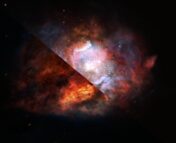Title: Kinematics and Star Formation of High-Redshift Hot Dust-Obscured Quasars as Seen by ALMA
Authors: Tanio Díaz-Santos, Roberto J. Assef, Peter R. M. Eisenhardt, Hyunsung D. Jun, Gareth C. Jones, Andrew W. Blain, Daniel Stern, Manuel Aravena, Chao-Wei Tsai, Sean E. Lake, Jingwen Wu, and Jorge González-López
First Author’s Institution: Núcleo de Astronomía de la Facultad de Ingeniería y Ciencias, Universidad Diego Portales, Chile, & Institute of Astrophysics, Foundation for Research and Technology–Hellas (FORTH), Greece & Chinese Academy of Sciences South America Center for Astronomy (CASSACA), National Astronomical Observatories, China
Status: Submitted to Astronomy & Astrophysics [closed access]
Imagine you’re at a backyard BBQ, someone just fired up the grill and no one’s really settled into their seats throughout the yard. All of a sudden, someone dumps gas on the grill and the hot dogs are glowing bright, with sparks flying and ashes getting kicked up, forming a dusty cloud around the supermassive black hole in the middle of the hot dogs. Okay, so we’ve moved on from the beginning of a (pretty wild) backyard bash to the early Universe (arguably more wild). Instead of mustard and ketchup, these hot dogs have gas and dust for condiments, and are super bright due to heaps of star formation and hot material spiraling in rapidly under the gravitational influence of an active, supermassive black hole.
Hot Dust-Obscured Galaxies (Hot DOGs, see also this Astrobite) are a type of quasar, and are some of the brightest objects in the Universe. Quasars are found in galaxies that are in a temporary mega-bright phase in which their central supermassive black hole (SMBH) vigorously funnels in material and creates a disk of hot, luminous gas and dust around it (an active galactic nucleus, or AGN). A complex gas recycling process goes on during the quasar phase: as gas comes in from the cosmic web or a merger with another gas-rich galaxy, the inflow of gas fuels both star formation and feeds the SMBH, which devours some and throws out the rest. Hot DOGs host quasars specifically classified for being detected via their dust emission, where short wavelength light from new stars and the glowing material around the SMBH gets absorbed and re-emitted to longer wavelengths by the cloak of dust surrounding the SMBH and throughout the galaxy.
Today’s authors observed and analyzed 7 Hot DOGs in the early Universe (redshift z ~ 3.0 – 4.6), seeking to answer questions about the nature of these powerful objects and how they fit into theories of galaxy evolution. All are Extremely Luminous at >1014 L☉, comparable to the brightest Hot DOG known, and among the most luminous objects in the Universe. The authors’ strategy was to use long wavelength observations to map out the motions of the interstellar medium–the fuel for star formation and AGN–without being hindered by dust obscuration of shorter wavelength light in the optical bands. Using the Atacama Large Millimeter/submillimeter Array (ALMA), they targeted [CII], a molecular emission line that is commonly used to trace the motions and content of gas, the main fuel source for luminous galaxies.
Diverse Dynamics, Common Turbulence
The authors found [CII] emission strongly detected in 4/7 of their Hot DOG sample, with 2/7 Hot DOG emission lines shifted out of the narrow window of their observations, and 1/7 with a tentative detection. Based on analysis of the detected emission lines, the Hot DOGs have a range of dynamical states, with some barely rotating, some with ordered, circular motions, and some complex, disturbed systems pointing to an ongoing galaxy merger. While the Hot DOGs aren’t dominated by a common velocity field, they do all have a high velocity dispersion, revealing highly turbulent gas. Figure 1 presents emission and kinematic results for one galaxy in the sample.
![Four different observational results for one galaxy in the sample. Top left shows dust emission, which is fairly compact and centralized in the core of the galaxy. Bottom left is [CII] emission intensity, which is similarly compact in the galaxy core. The top right panel shows [CII] velocity dispersion, which is highly turbulent at ~500 km/s. The bottom right panel maps the dynamical state of the galaxy, which has a smooth gradient from moving slightly towards to moving slightly away, displaying a uniform, rotating disk structure.](https://astrobites.org/wp-content/uploads/2021/04/hotdogfig-1024x792.png)
The authors argue that the strong [CII] emission is powered by a combination of enhanced star formation and the quasar’s characteristic AGN, as both sources would heat the dust and increase the brightness of the emission line. In addition the AGN may impact the surrounding material by stirring up the gas and creating turbulence, which could also increase the brightness and width of the line.
The rise and fall (and rise again?) of Hot DOGs
After comparing to other populations of extremely bright or active galaxies both nearby and in the distant Universe, the authors interpret the rise of Hot DOGs in a galaxy evolution context. The current understanding of extremely luminous quasars is that they are a short phase within the merger process of two massive, gas-rich star-forming galaxies. As they begin merging, gas and dust pile up in the middle which sparks star formation and spirals onto the SMBH creating the AGN. While in this dusty phase, these quasars are detected in the longer, infrared wavelengths. Then, as the quasar feedback causes material to be thrown out from the central AGN, the material in the middle gets cleared out and the quasar shines brightly in the optical.
However, the story may be a little different at earlier times in the Universe when galaxies tended to have higher gas content in general. Extremely luminous quasars in the early Universe likely formed at dense knots of the cosmic web, where smaller galaxies and rivers of gas flow into the overdense knot, supplying fuel to the galaxy smoothly rather than in a major merger of two big galaxies. Here, the Hot DOG would rapidly pull in small nearby galaxies and clumps of gas, replenishing its gas reservoir and maintaining high levels of turbulence. This idea is supported by the sample’s diversity of velocity fields and consistently large line velocity dispersions, providing a clear signature for turbulence which may be characteristic of Hot DOGs.
The authors also discuss the possibility of recurrent Hot DOG stages. While a major merger event is more of a one time thing, steady gas inflow and mergers with smaller nearby galaxies could fuel Hot DOG stages more than once in a galaxy’s evolution. Hot DOG events could happen on short timescales multiple times, particularly in an overdense environment like a protocluster, where a chaotic conglomeration of gas and galaxies piles together in a chaotic mess of fuel and activity. Almost like one backyard that the entire neighborhood uses to host BBQs every day of the summer!
Still, these possible explanations for the nature of Hot DOGs remain only possibilities. With a small sample size and some tentative detections and non-detections, as always we need more data to be certain about their cause, their recurrence, and their role in the formation and evolution of massive galaxies. So fire up the grill and we’ll point a telescope at it!
Astrobite edited by Katy Proctor
Featured image credit: ESO/M. Kornmesser (quasar) & Pixabay (grill)




